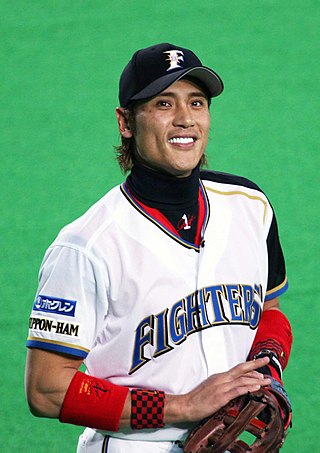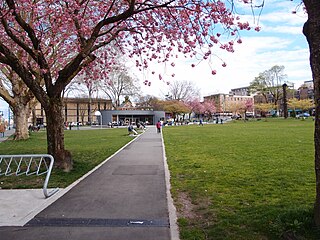
Issei are Japanese immigrants to countries in North America and South America. The term is used mostly by ethnic Japanese. Issei are born in Japan; their children born in the new country are nisei ; and their grandchildren are sansei.
Sansei is a Japanese and North American English term used in parts of the world to refer to the children of children born to ethnically Japanese emigrants (Issei) in a new country of residence, outside of Japan. The nisei are considered the second generation, while grandchildren of the Japanese-born emigrants are called Sansei. The fourth generation is referred to as yonsei. The children of at least one nisei parent are called Sansei; they are usually the first generation of whom a high percentage are mixed-race, given that their parents were (usually), themselves, born and raised in America.
Joy Nozomi Kogawa is a Canadian poet and novelist of Japanese descent.
The Japanese Baseball League was a professional baseball league in Japan which operated from 1936 to 1949, before reorganizing in 1950 as Nippon Professional Baseball.

From 1942 to 1949, Canada forcibly relocated and incarcerated over 22,000 Japanese Canadians—comprising over 90% of the total Japanese Canadian population—from British Columbia in the name of "national security". The majority were Canadian citizens by birth and were targeted based on their ancestry. This decision followed the events of the Japanese Empire's war in the Pacific against the Western Allies, such as the invasion of Hong Kong, the attack on Pearl Harbor in Hawaii, and the Fall of Singapore which led to the Canadian declaration of war on Japan during World War II. Similar to the actions taken against Japanese Americans in neighbouring United States, this forced relocation subjected many Japanese Canadians to government-enforced curfews and interrogations, job and property losses, and forced repatriation to Japan.

Japantown, Little Tokyo or Paueru-gai is an old neighbourhood in Vancouver, British Columbia, Canada, located east of Gastown and north of Chinatown, that once had a concentration of Japanese immigrants.
Masajiro Miyazaki, CM was a Canadian osteopathic physician who practised in Vancouver prior to World War II. During World War II, he was appointed as a coroner by the British Columbia Provincial Police in the town of Lillooet, British Columbia. In addition to coroner's duties he also served as effective general practitioner in the Lillooet area, including for the area's four wartime "self-supporting centres". Miyazaki's practice also included the Japanese Canadian internment camp at Taylor Lake. Towards the end of his life, Miyazaki was recognized for his services to the community, which included founding the local ambulance service and instigating a proper hospital for Lillooet, by being enrolled in the Order of Canada.

Tsuyoshi Shinjo, also known as BIGBOSS, is a former Japanese professional baseball outfielder and the current manager for the Hokkaido Nippon-Ham Fighters of Nippon Professional Baseball (NPB).

Oppenheimer Park is a park located in the historic Japantown (Paueru-Gai) in the Downtown Eastside, Vancouver, British Columbia, Canada.
Japanese Canadians are Canadian citizens of Japanese ancestry. Japanese Canadians are mostly concentrated in Western Canada, especially in the province of British Columbia, which hosts the largest Japanese community in the country with the majority of them living in and around Vancouver. In 2016, there were 121,485 Japanese Canadians throughout Canada.
Hisaye Yamamoto was an American author known for the short story collection Seventeen Syllables and Other Stories, first published in 1988. Her work confronts issues of the Japanese immigrant experience in America, the disconnect between first and second-generation immigrants, as well as the difficult role of women in society.
Nisei is a Japanese-language term used in countries in North America and South America to specify the ethnically Japanese children born in the new country to Japanese-born immigrants. The Nisei are considered the second generation and the grandchildren of the Japanese-born immigrants are called Sansei, or third generation. Though nisei means "second-generation immigrant", it often refers to the children of the initial diaspora, occurring in the late 19th and early 20th centuries, and overlapping with the G.I. and silent generations.
Hitoshi "Mel" Wakabayashi was a Canadian-Japanese ice hockey player, a right-handed center, who played for the 1964 NCAA champion Michigan Wolverines hockey team. He was also named Player of the Year in the Western Collegiate Hockey Association in 1966. He went on to play 11 seasons in the Japan Ice Hockey League and to coach the Japan men's national ice hockey team at international competitions, including the 1980 Winter Olympics. After his hockey career ended, Wakabayashi became the President of Seibu Canada. In 2001, Wakabayashi was selected by the WCHA as one of the Top 50 Players in 50-year history of the conference. He was also inducted into the University of Michigan Athletic Hall of Honor in 2006.

The Vancouver Asahi is a 2014 Japanese-Canadian coproduced baseball drama film directed by Yuya Ishii, based on the true story of a Vancouver-based baseball team called the Vancouver Asahi which existed before the Second World War. It was released to Japanese theaters on December 20.

Koichi Sekikawa is a Japanese former Nippon Professional Baseball Catcher, Outfielder, and current the field player coordinator for the Fukuoka SoftBank Hawks of Nippon Professional Baseball (NPB).
Issei Takazaki is a Japanese professional shogi player ranked 7-dan.

The history of Japanese people in British Columbia began with the arrival of Manzo Nagano in New Westminster in 1877. Prior to 1942, British Columbia was home to 90% of all Japanese in Canada. In 2001, 44% of all Japanese Canadians lived in British Columbia, or about 1% of the province's total population.

Les Maruo is a Japanese professional gridiron football linebacker for the Winnipeg Blue Bombers of the Canadian Football League (CFL).
The TashmeIncarceration Camp was a purpose-built incarceration camp constructed to forcibly detain people of Japanese ancestry living on the West Coast of Canada during World War II after the attack on Pearl Harbor. Located at the current unincorporated community of Sunshine Valley, east of Hope in British Columbia, Canada, Tashme was operational between 1942 and 1946 and had a peak population of 2,624 people to 2,636 people. Tashme was constructed on 600 acres of leased land for $500/year on the A.B. Trites Farm.









